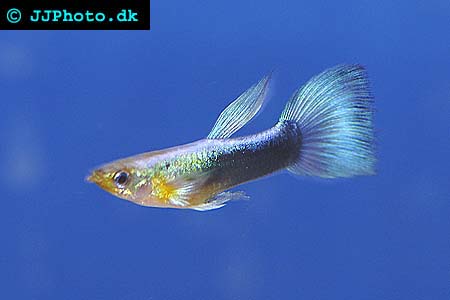Tag Archives: guppies
Fast paced evolution
We often think of evolution as something extremely slow that takes place over the course of thousands or even millions of years. The truth is however that certain adaptations can occur very quickly, sometimes over the course of just a few generations.
Male Guppy. Copyright www.jjphoto.dk
Eight years later, a time period equivalent of less than 30 guppy generations, the guppies living in the low-predation environment had adapted to this environment by producing larger and fewer offspring with each reproductive cycle.
“High-predation females invest more resources into current reproduction because a high rate of mortality,
driven by predators, means these females may not get another chance to reproduce,” explained Gordon, who works in the lab of David Reznick, a professor of biology.
The guppies living below the barrier waterfall where there were a lot of predators did not show any signs of producing fewer or larger offspring.
“Low-predation females, on the other hand, produce larger embryos because the larger babies are more competitive in the resource-limited environments typical of low-predation sites”, Gordon said. “Moreover, low-predation females produce fewer embryos not only because they have larger embryos but also because they invest fewer resources in current reproduction.”
The paper will be published in the July issue of The American Naturalist.
Swanne Gordon’s research team included David Reznick and Michael Bryant of UCR; Michael Kinnison and Dylan Weese of the University of Maine, Orono; Katja Räsänen of the Swiss Federal Institute of Technology, Zurich, and the Swiss Federal Institute of Aquatic Science and Technology, Dübendorf; and Nathan Miller and Andrew Hendry of McGill University, Canada.
Financial support for the study was provided by the National Science Foundation, the Natural
and Engineering Research Council of Canada, the Le Fonds Québécois de la Recherche sur la Nature
et les Technologies, the Swedish Research Council, the Maine Agricultural and Forestry Experiment
Station, and McGill University.
Stingray mass death in U.S. Zoo
Eleven of the 18 freshwater stingrays living at the U.S. National Zoo died over the holiday weekened, together with two arowanas. All dead fishes were residents of the zoo’s Amazonia exhibit; a 55,000-gallon (208,000 L) aquarium designed to replicate a flooded Amazon forest. Zoo officials are now suspecting low oxygen levels to be behind the sudden mass death.
Picture of Motoro Sting Ray, Ocellate river stingray – Potamotrygon motoro. Not one of the dead rays.
Copyright www.jjphoto.dk
As soon as the deaths were discovered 7 a.m Monday morning, zookeepers tested the water and found low levels of dissolved oxygen. They immediately started supplementing the aquarium with reservoir water and no more fish have died so far. In addition to stingrays and arrowanas, the Amazon aquarium is also home to discus, boulengerella fish, and a large school of guppies. By 10:15 a.m. Monday, the oxygen levels were back to normal but zookeepers continue to monitor the health of the surviving fish just in case.
Necropsies performed on the dead fish did not unveil any definite cause of death, which makes low oxygen levels even more likely, according to National Zoo officials. They do not believe human error caused the oxygen drop, since all protocols and checks were properly followed Sunday night.
Insufficient levels of dissolved oxygen in the water are one of the most common causes of fish mass death, in the wild as well as in captivity. Last year, 41 stingrays died at the Calgary Zoo in Canada due oxygen scarcity in the water.

